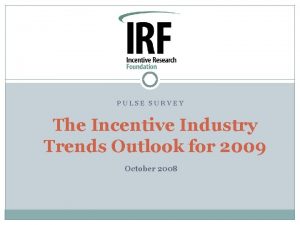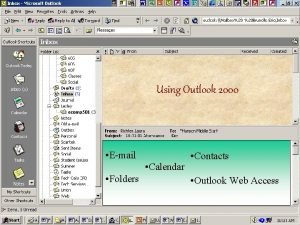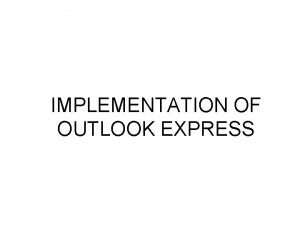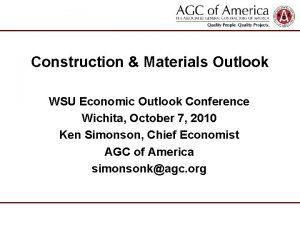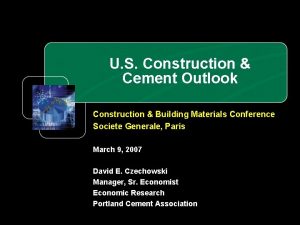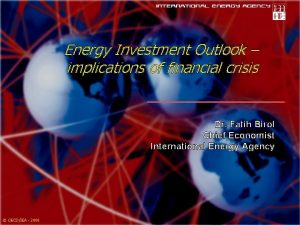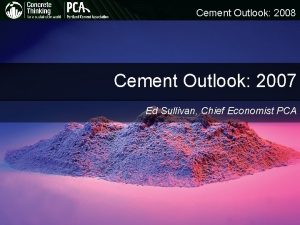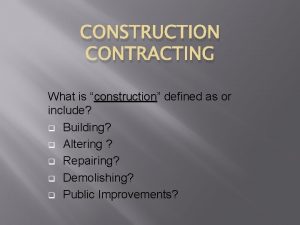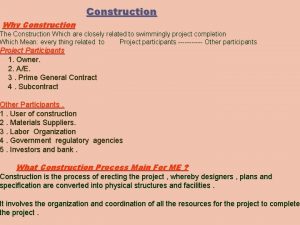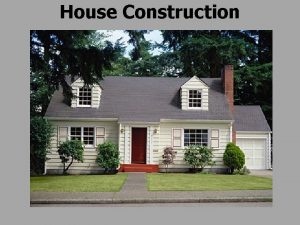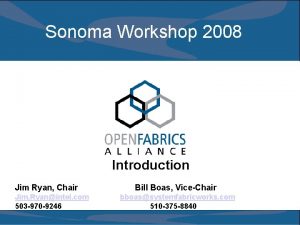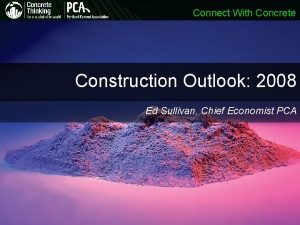Construction Trends and Outlook for 2008 Jim Haughey









































- Slides: 41

Construction Trends and Outlook for 2008 Jim Haughey, Ph. D Director of Research and Analytics, Reed Construction Data January 8, 2008 New York

7, 000+ industry professionals provide insight on public real estate companies, direct investment due diligence, property valuations, and real-estate market fundamentals © 2007 Gerson Lehrman Group Inc. , All Rights Reserved

Council Member Biography: Jim Haughey, Ph. D, is Director of Research and Analytics at Reed Construction Data in Massachusetts, where he has over thirty years as a business economist and includes twenty years of monitoring the construction industry. Dr. Haughey responsible for economic research, analysis and commentary for various construction market segments, custom research, and industry related speaking engagements. He is also involved with the Reed Construction Starts database and he will work closely with RCD strategic partner, Property & Portfolio Research, a leading independent provider of commercial real estate research and risk management advisory services. Prior to his appointment at Reed Construction Data, Dr. Haughey served as the Director of Economics for Reed Business Information preparing detailed construction market forecasts appearing in many Reed construction related magazines. He also frequently lectured on the construction outlook at events sponsored by trade associations, trade unions and construction suppliers. He holds a Ph. D. in economics from the University of Michigan, and earned his M. B. A. from Eastern Michigan University. In addition to his work as an economist, he has taught at the University of Michigan, Ohio University, Michigan State University and the University of Massachusetts. His career includes positions with Ford Motor Company, Standard Oil, Cahners and most recently, Reed Business Information. © 2007 Gerson Lehrman Group Inc. , All Rights Reserved

Topics ► Construction demand outlook ► Construction costs and funding trends ► Non-residential, residential and public works construction activity ► Trends in building material and equipment sales © 2007 Gerson Lehrman Group Inc. , All Rights Reserved

About GLG Institute (GLGi. SM) is a professional organization focused on educating business and investment professionals through in-person meetings. It is designed to revolutionize the professional education market by putting the power of programming into the hands of the GLG community. GLGi hosts hundreds of Seminars worldwide each year. GLGi clients receive two seats to all Seminars in all Practice Areas. GLGi’s website enables clients to: ► Propose Seminar topics, agenda items and locations ► View and RSVP to scheduled and proposed Seminars ► Receive a daily briefing with new posts on your favorite tickers, subject areas and from trusted Council Members ► Share Seminar details with colleagues or friends © 2007 Gerson Lehrman Group Inc. , All Rights Reserved

Gerson Lehrman Group Contacts REAL ESTATE (RE) Justin Stein Director of Real Estate (RE) Gerson Lehrman Group + 1 212 -750 -1809 jstein@glgroup. com Aaron Liberman Managing Director, Sales and Marketing Gerson Lehrman Group +1 212 -984 -3684 aliberman@glgroup. com Carly Pisarri Process Manager Research Operations Gerson Lehrman Group +1 212 -750 -1435 cpisarri@glgroup. com © 2007 Gerson Lehrman Group Inc. , All Rights Reserved

2008 Construction Trends GLG Seminar New York City January 8, 2008 Jim Haughey Chief Economist Reed Construction Data

Outline • Economic support for construction fragile but positive • Funding adequacy and cost constraints continue • NR building boom is over but no decline • Civil construction expands slowly • Residential collapse ends but slow recovery • Construction cost trends turn up • Materials and equipment sales steady to slightly up

2008 -09 Economic Environment for Construction • • • Subpar GDP growth Weaker labor market Domestic price inflation ebbs Inflation rises for world priced goods Supply of funds tightens – falling profits, slower tax receipt growth, lower investment returns and restrained federal funding • Some US regions in recession

Subpar GDP Growth % ’ 06 2. 9% ’ 07 2. 2% inventory building & export expansion ’ 08 2. 5% ’ 09 2. 9%

Weaker Labor Market • Unemployment rate rises from 4. 7% to 5. 0% or more • Job growth slows from 1. 4 million in 2007 to 1. 15 million in 2008 • Wage gains fall from 3. 9% in 2007 to 3. 6% in 2008; union wage gains stronger • Fewer shortages of skilled workers in 2008 • Impact of immigration enforcement?

Inflation: Domestic Ebbs; World Rises • Construction examples - 12 mo. % change Gypsum products -23. 0% Diesel fuel 50. 5% Softwood lumber -3. 5% Plastic resins 6. 0% Engineered wood -6. 3% Structural steel 5. 7% Brick -0. 9% Nonferrous pipe 4. 4% Flat glass -1. 0% Cement Ceramic tile 3. 6% 1. 2% Declining $US and near 5% GDP growth outside the US will keep this divergent trend through 2008

Construction Funds Tighter • Profits down in Q after rising 62% in the previous four years • States budgeted for a 1. 0% real gain in tax receipts in FY 08 after two years with 5% plus gains • Equity, fixed income and real estate investment returns lower at end of cycle • Bush gets tough on federal spending gains, FY 08 budget delayed and Highway Trust Fund approaches bankruptcy

Capacity Stressed Financial Market Restrains Construction • Subprime and related high risk asset losses not yet permanently covered (or even known)…. . • Most serious impact on SF and condo • Spillover impact on private commercial • Delayed impact on institutional buildings and public works • As a result, gradually spreading impact on all construction market suppliers

Investor Adjustments Enter Final Stage • Credit crunch postponed by temporary liquidity injections from central banks • FRB’s Temporary Auction Facility (TAF) will set prices for subprime and other assets that rating agencies failed to price properly • This will unlock hoarded cash, permitting trading to resume so investors can measure their losses, write them off and move on • This will take several months; new loss reserves may equal capital write offs to date • Non-prime and commercial mortgages will be more available and cheaper in the spring

Asset Value Uncertainty Impact in Mid-December • All but shut down adjustable rate subprime mortgage market – Had been 40% of total market in Southwest, Fl, industrial Midwest and some large urban areas • Reduced jumbo mortgages by about 50% – Primarily in CA, Fl coasts and Northeast • Raised commercial mortgage rate 100 points – More impact on real estate than construction • Set off recession, tax receipt cuts and public construction cancellations in some regions

Regional Recessions Begin • Recessions now underway in Florida, Nevada, Michigan, Alaska as well as much of California and other Midwest industrial areas • Recession possible soon in…. . – New York – financial market bonus cuts and layoffs – Washington DC –less growth in federal spending • Strong economic growth continues in…. . – MA, NH, WA, SC, GA, MS, LA, KS, UT, WY

State economic growth-Oct 2007 Philadelphia FRB Economic Activity Index – 3 mo. annualized

Does NR Follow Residential? Rapid growth states with below average housing starts decline NR starts YTD WY 118. 7% NH -8. 5% LA 72. 9% SC -8. 5% MA 30. 8% MS 27. 2% KS WA 22. 2% 12. 4% US = +3. 8%

Does NR Follow Residential? Low growth states with above average housing starts decline NR starts YTD MI -22. 7% MN 84. 4% PA -12. 2% NV 77. 7% AR -2. 3% FL 55. 7% MO 2. 8% WV 30. 1% US = 3. 8% KY 17. 3% MT 9. 1%

NR Building Starts Dip Value of starts $B 3 mma, nsa Source: RCD

NR Const. Spending Growth Now Slowing ’ 06 12. 7% ’ 07 16. 6% Ann. % change ’ 08 11. 4% ’ 08 7. 8% Stall but no decline

“For Lease” Outlook ann. % change in construction spending • Vacancy rates now edging up • Rental rate gains easing • Space demand growth slowing • Building asset prices stabilizing • Financing cost higher ’ 07 ’ 08 ’ 09 Hotel 65% 27% 13% Retail* 13% 4% 4% Office 20% 14% 11% * Includes warehouse

Institutional Outlook ann. % change in construction spending • Hospital income increased rapidly • State/local tax receipts and investment earnings soared in 04 -07 but now rising slower • State budget reserves peaked at 10. 2% in FY 06 – will fall to 45% in FY 09 ’ 07 Health 14% Ed 14% Religious -1% Public* 30% Amuse/ 13% Recreation ’ 08 ’ 09 16% 12% 9% 5% 8% 13% 15% 5% 16% 10% * police, fire, jail, court

Manufacturing Outlook construction spending $M Spending doubles from ’ 04 to ’ 09 but the gain in 07 -09 is largely project cost increases • • Mfg. production grows slower than productivity • Current capacity is only modestly strained

Civil Starts Remain Strong Value of starts $B 3 mma, nsa Source: RCD Recent dip is mostly seasonal

Civil Spending Growth Steady ’ 06 12% ’ 07 12% Ann. % change ’ 08 12% ’ 09 12% 06 -09 growth is mostly inflation

Civil Outlook ann. % change in construction spending • Highway Trust Funds near bankruptcy • Surge of private money for highway projects • Power & Transportation boosted by strained capacity • Water/Sewer spending slowed by fewer new residential areas ’ 07 ’ 08 ’ 09 Highway 7% 8% 11% Power 22% 18% 16% Trans. 20% 14% 11% Telcomm 15% 17% 14% Conser 6% 6% 7% vation Water/ 7% 9% 8% Sewer

Housing Market Near Bottom housing starts, (000’s), saar ’ 06 -12. 6% ’ 07 -25. 0% Only 40% of 2006 -07 decline is recovered by the end of 2009 ’ 08 -10. 1% ’ 09 +21. 2% Approx. normal prime conforming market

Housing Starts Outlook Housing Starts (000's) 2006 2007 2008 2009 Total 1812 1370 1221 1480 Single Family Multi Family Northeast Midwest South West 1474 338 171 284 912 445 1058 311 147 212 682 328 889 333 152 199 580 290 1130 350 165 244 713 359

Current Housing Market Situation • “For sale” inventory double normal • Home prices will fall 5% more • New home inventory declining – more decline needed • Existing home inventory steady or slightly declining – much more decline needed • Home affordability above average and rising • Offset by consumer confidence below average and falling

Home Affordability Improving Index

Consumer Confidence Declining

Multi-Family Outlook • Condo starts have fallen more than 30% – Speculative and second home markets depressed by falling home price – Adjustable subprime and jumbo market depressed by mortgage turmoil • Offset by rising apartment demand – Apartment supply was contracting when SF market began to collapse – Developers attracted by rising rents and declining vacancies • MF starts above ’ 06 level and rising

Hot Housing Markets (10, 000 min. ) Permits last 12 months Raleigh Charlotte Austin Las Vegas Houston Orlando Atlanta Nashville Phoenix Jacksonville 16125 22113 21364 24716 63189 19478 47511 13323 36233 10370 4. 2 3. 6 3. 5 3. 0 2. 5 2. 4 2. 3 2. 1 Permits/1, 000 population, ratio to US Seattle San Antonio Dallas Portland Denver Riverside Tampa Washington 26215 14235 42046 13154 14736 23424 12396 22251 2. 1 1. 9 1. 8 1. 6 1. 5 1. 2 1. 1

Housing Permit Change Since 12/05 -2/06 Average Deep Recession Atlanta -7888 Phoenix -6958 Miami -6619 Riverside -6612 Cape Coral -5687 Dallas -4662 No Recession Las Vegas +1620 Seattle +1412 New Orleans +910 Omaha +693 Gulfport-Biloxi +397 San Jose +204

Materials Cost to Surge Again • Five month pause is over - materials cost rising again well into 2008 – Costs were unchanged from May to October – Materials price index rose 1. 4% in November – 2007 -08 surge led by energy, metals, cement – all prices in world markets – Prices will continue to fall for lumber and gypsum – Prices will continue to be steady to slightly up for manufactured items • 2008 -09 price outlook – about 4%/year

Price Increase Since Jan ‘ 03 Construction inflation will continue to exceed overall % inflation

Key 2008 Price changes ’ 08 avg. vs. ‘ 07 avg. • • Steel: 10 -15% - current low inventories Diesel: -7% - but still $3. 00/gal. Cement: 5 -6% - more imports Nonferrous metal: 0. 0% - recent decline to be offset by renewed Chinese buying • Softwood lumber: -15% - prices stay near recent level • Gypsum products: -23% - prices drop further at least through the winter

Materials Market Recovery Begins in 2008 Production index 1998 = 100

Spending Drives Production Gain Total construction spending , % chge. at annual rate, incl. inflation ’ 06 5. 6% ’ 07 -2. 5% ’ 08 4. 1% ’ 09 9. 4%
 2008 2008
2008 2008 World energy outlook 2008
World energy outlook 2008 Outlook for corporate incentive travel programs
Outlook for corporate incentive travel programs Fspos vägledning för kontinuitetshantering
Fspos vägledning för kontinuitetshantering Novell typiska drag
Novell typiska drag Nationell inriktning för artificiell intelligens
Nationell inriktning för artificiell intelligens Ekologiskt fotavtryck
Ekologiskt fotavtryck Varför kallas perioden 1918-1939 för mellankrigstiden
Varför kallas perioden 1918-1939 för mellankrigstiden En lathund för arbete med kontinuitetshantering
En lathund för arbete med kontinuitetshantering Adressändring ideell förening
Adressändring ideell förening Tidbok yrkesförare
Tidbok yrkesförare A gastrica
A gastrica Vad är densitet
Vad är densitet Datorkunskap för nybörjare
Datorkunskap för nybörjare Stig kerman
Stig kerman Debattartikel mall
Debattartikel mall För och nackdelar med firo
För och nackdelar med firo Nyckelkompetenser för livslångt lärande
Nyckelkompetenser för livslångt lärande Påbyggnader för flakfordon
Påbyggnader för flakfordon Vätsketryck formel
Vätsketryck formel Offentlig förvaltning
Offentlig förvaltning I gullregnens månad
I gullregnens månad Presentera för publik crossboss
Presentera för publik crossboss Jiddisch
Jiddisch Kanaans land
Kanaans land Treserva lathund
Treserva lathund Luftstrupen för medicinare
Luftstrupen för medicinare Claes martinsson
Claes martinsson Cks
Cks Verifikationsplan
Verifikationsplan Mat för unga idrottare
Mat för unga idrottare Verktyg för automatisering av utbetalningar
Verktyg för automatisering av utbetalningar Rutin för avvikelsehantering
Rutin för avvikelsehantering Smärtskolan kunskap för livet
Smärtskolan kunskap för livet Ministerstyre för och nackdelar
Ministerstyre för och nackdelar Tack för att ni har lyssnat
Tack för att ni har lyssnat Referatmarkering
Referatmarkering Redogör för vad psykologi är
Redogör för vad psykologi är Matematisk modellering eksempel
Matematisk modellering eksempel Tack för att ni har lyssnat
Tack för att ni har lyssnat Borra hål för knoppar
Borra hål för knoppar Vilken grundregel finns det för tronföljden i sverige?
Vilken grundregel finns det för tronföljden i sverige?


